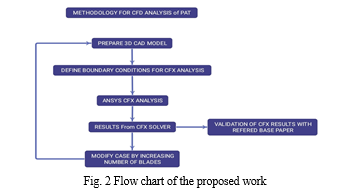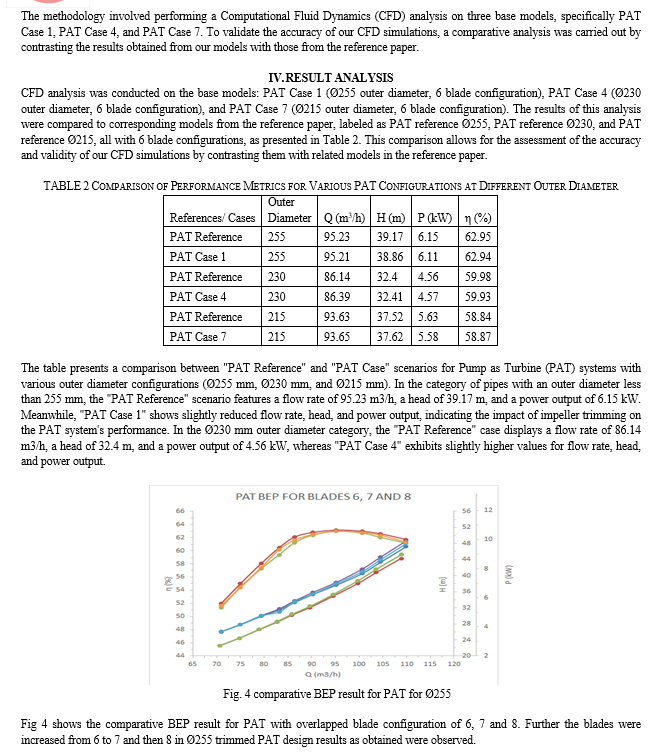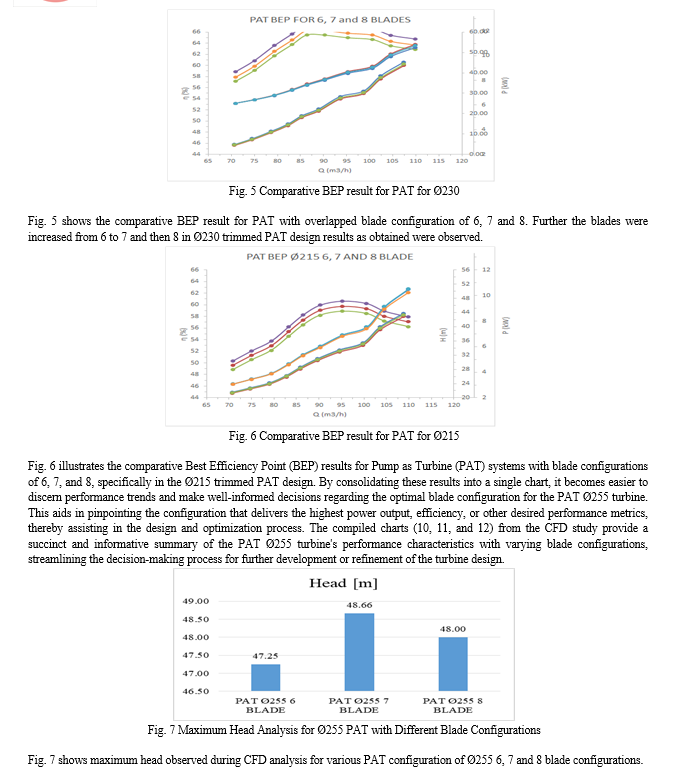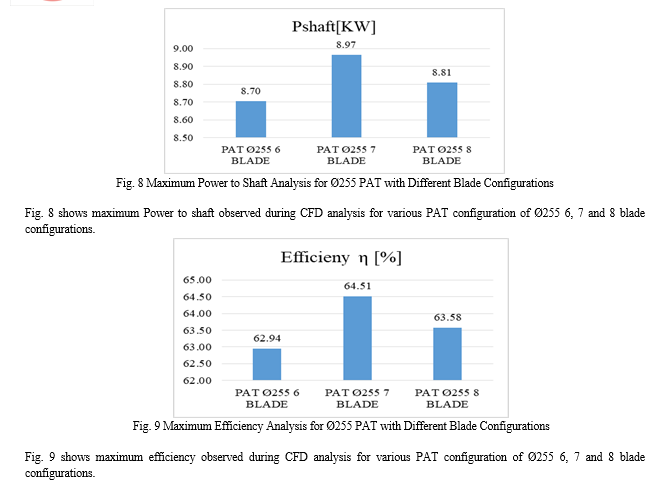Ijraset Journal For Research in Applied Science and Engineering Technology
- Home / Ijraset
- On This Page
- Abstract
- Introduction
- Conclusion
- References
- Copyright
Enhancing Hydropower Generation through Pump as Turbine (PAT) System Optimization
Authors: Pramod Kumar Shakya, Dr. Aseem C Tiwari
DOI Link: https://doi.org/10.22214/ijraset.2023.56283
Certificate: View Certificate
Abstract
Pump as Turbine (PAT) systems, operating in reverse mode to transform mechanical energy into hydraulic energy, pose unique challenges in the pursuit of optimal performance for hydropower generation. This research leverages the power of ANSYS CFD/CFX simulations to delve into the impact of various impeller trimming configurations on the efficiency and effectiveness of PAT systems in the context of hydropower generation. The research involves a systematic approach that includes CAD modeling and meshing to analyze three base models: PAT Case 1 (Ø255 mm, 6 blades), PAT Case 4 (Ø230 mm, 6 blades), and PAT Case 7 (Ø215 mm, 6 blades). To validate the simulations, a comparison is made with reference models (PAT reference Ø255 and 6 blade configuration, PAT reference Ø230 and 6 blade configuration, PAT reference Ø215 and 6 blade configuration). The findings of this study show that increasing the number of blades from 6 to 7 results in significant improvements in head, power output, and efficiency. However, further increases to 8 blades demonstrate diminishing efficiency gains. Moreover, reducing the impeller diameter proves to be a beneficial factor in enhancing overall system performance. Among the configurations tested, the Ø215 mm diameter with 7 blades stands out as the top-performing option. This design offers promising potential for maximizing pump efficiency in practical hydropower applications.
Introduction
I. INTRODUCTION
Nowadays large numbers of potential hydropower resources are still underutilized, such as existing medium and small irrigation dam, weir, and waterfalls. These prospective locations, often referred to as "Micro hydropower" sites, possess a power capacity of less than 200 kW, demanding a distinct hydro generating system to ensure efficient operation in contrast to their larger hydro counterparts. A significant impediment hindering the development of these Micro hydropower resources is the exorbitant cost associated with hydro turbine systems. In Micro hydropower projects, the expenses linked to electro-mechanical components typically fluctuate between 35% and 40% of the total project cost. To address this formidable challenge, a pragmatic solution emerges through the deployment of centrifugal pumps used in a reverse operation mode, known as "Pump-as-Turbine" (PaT). In this innovative approach, traditional pumps are operated in a reverse direction, diverging from their typical pumping function, to serve as efficient turbines. The primary advantage of adopting the Pump-as-Turbine (PaT) concept in Micro hydropower applications lies in its remarkable cost-effectiveness. This is chiefly because the global production of centrifugal pumps vastly exceeds that of traditional turbines. Consequently, the cost of implementing PaT systems is estimated to be approximately 50% lower compared to equivalent turbine systems [1]. This not only offers a financially viable solution but also contributes to the sustainable development of Micro hydropower projects, making them more accessible and economically feasible.The discovery of PAT emerged serendipitously when Thoma and Kittredge recognized that hydraulic pumps could effectively function as turbines when operated in reverse mode. Subsequently, this concept garnered substantial interest from researchers worldwide. In their comprehensive exploration of pumps operating in reverse mode, Agostinelli and Shafer arrived at a significant finding: when a centrifugal pump takes on the role of a turbine, it showcases a remarkably smooth and reliable mechanical performance. This observation has contributed to the widespread adoption of centrifugal pumps as Pump-as-Turbine (PAT) systems. Such a preference is underpinned by the inherent similarities in the operational principles of centrifugal pumps and Francis turbines, as thoughtfully documented in [2]. The functional model of the PAT system consists of various integral components, each playing a crucial role in its successful operation. This model comprises a volute, front and back chambers, inlet and outlet extensions, and a specially designed impeller featuring six balancing holes for improved performance and stability. The detailed depiction of this PAT model can be observed in Figure 1, offering a visual representation of its structural and operational elements. This engineered design, inspired by the principles shared with traditional Francis turbines, serves as a testament to the innovative approach of harnessing centrifugal pumps for energy generation in the form of PAT systems.

The monitoring position applied throughout the experiment was taken into consideration when calculating the lengths of the inlet extension and outlet extension [3]. In recent years, the concept of Micro Hydropower Plants (MHP) designed around the utilization of Pump as Turbine (PAT) technology for remote off-grid electrification has garnered attention from institutions dedicated to rural energy supply. This trend has been fueled, in part, by the economic advantages associated with such designs. It is worth noting that while MHPs based on PAT offer a straightforward user interface and are economically viable, they are not without their share of challenges that necessitate thorough understanding and resolution. Existing research findings, as reported in numerous publications [4], underscore the multifaceted nature of MHPs based on PAT technology. One notable issue is the relative scarcity of academic literature dedicated to PAT technology compared to other clean energy technologies. This knowledge gap has contributed to a lack of community-wide comprehension about PAT's potential and limitations. It is evident that there is much ground to cover in terms of research and dissemination of insights in this field. Additionally, another challenge lies in the fact that pump manufacturers typically do not provide characteristic curves for their pumps when operating in reverse as turbines. This absence of crucial data creates a primary obstacle when attempting to establish a correlation that facilitates the transition from "pump" functionality to "turbine" characteristics. Addressing this challenge is pivotal to unlock the full potential of employing pumps as turbines for micro hydropower applications [5]. In conclusion, while the economic benefits are evident, there is still a need for comprehensive research, knowledge dissemination, and overcoming practical challenges to fully harness the potential of PAT-based MHPs in remote off-grid electrification.
II. LITERATURE REVIEW
The recent literature underscores the significant emphasis on recuperating surplus energy within water supply networks. In pressurized systems, the utilization of pumps in an inverse mode, known as "Pump As Turbine" (PAT), has emerged as an economically efficient and dependable alternative compared to conventional energy production devices (EPDs). Given the substantial fluctuations in flow rate and head drop inherent in water distribution networks, the operation of PATs can be effectively managed through a series-parallel regulation system, driven by electronic or hydraulic principles. While Pump as Turbine (PAT) systems and their associated regulation and control systems are cost-effective, the widespread adoption of small hydro power plants within water distribution networks faces a significant challenge: the need for additional civil works to accommodate the entire plant. However, this paper introduces a novel, economically viable technology, informed by a combination of laboratory experiments and numerical simulations. This technology effectively addresses most of the current limitations, particularly in scenarios where energy availability is low, and discharge variations are high. Drawing inspiration from a real-world case study, this paper focuses on optimizing the operational conditions of the power plant. Specifically, it fine-tunes the system to perform optimally even in challenging conditions. In cases where larger power plants deploy more efficient semi-axial submersed pumps, the energy conversion ratio can witness a remarkable increase of up to 40%. This stands in stark contrast to the laboratory prototype, which exhibited a significantly lower efficiency of 16%. The prototype employed small centrifugal pumps, suitable for the analyzed case study, but the study's findings highlight the potential for substantial improvements when more efficient components are employed. This research not only sheds light on the innovative strides being made in enhancing hydro power generation but also underscores the considerable gains that can be achieved in harnessing energy from water distribution systems. The results of a research by Carravetta, A., et al. (2022) [6] could be useful for network managers and technicians interested in increasing the energy efficiency of the network and in recovering energy in the peripheral branches of the network were a large variability of small flow rates are present.
Large vaned-voluted centrifugal pumps, commonly used for substantial-scale water diversion, possess the versatility of reversible operation, gaining prominence with the shift towards reducing carbon emissions and adopting less stable renewable energy sources. In a groundbreaking 2022 numerical simulation study led by prominent researchers, including Yang, S., a comprehensive analysis of large pumps was undertaken, encompassing their performance and flow characteristics during both positive and negative rotations. The study placed a strong emphasis on the pumps' ability to operate at peak efficiency, especially under varying flow rates and head pressures. Employing meticulous error analysis and mathematical formulas, the research probed flow energy dissipation (FED) across a range of flow rates and rotational scenarios, revealing notable energy loss areas within the pump system at the suction side of blades, the blade's inlet and outlet sections, and the tail of the guide blade head. A comparative examination of energy dissipation patterns under pump and turbine modes demonstrated distinct characteristics. These findings carry significant implications for advancing low-carbon power grids and promoting clean energy production. In this context, Pump-as-Turbine (PaT) technology emerges as a cost-effective and versatile solution, with the widespread availability of pumps globally, although further research and optimization of performance prediction models are warranted to harness its full potential for sustainable hydropower applications. In a recent study by Akbar Telikani et al. (2023) [8], an innovative approach is presented. It leverages evolutionary Artificial Neural Networks (ANNs) based on the JADE algorithm to predict the Best Efficiency Point (BEP) and performance curves of PaTs, utilizing operational pump data. JADE serves as the optimizer for basic ANNs, enhancing parameter values for learning rates, weights, and biases. The model's accuracy is rigorously evaluated against experimental data available in the literature and compared with a basic ANN and two differential evolution algorithm versions. The findings from this study are further substantiated through experimental validation on a Pump-as-Turbine (PaT) system, showcasing the remarkable effectiveness of this approach with an impressive average R2-value of 0.97. This outperforms conventional Artificial Neural Networks (ANN) by a notable 5%. The significance of this research becomes particularly evident when considering the potential repercussions of pressure variations within the vaneless area in high-head pump turbines, as illuminated by engineering research conducted by Zhigang Zuo and colleagues in 2015 [9]. These pressure fluctuations have the capacity to induce dangerous hydraulic instabilities, such as vibration and fatigue failure in hydraulic components. It is well-established that the primary cause of these pressure changes in the vaneless space lies in the interactions between rotor blades and guide vanes, known as rotor-stator interactions (RSI). However, a notable challenge in implementing PaT systems lies in the selection of the appropriate pump for conversion to turbine mode at a specific site. The criteria for choosing a suitable reverse running pump encompass considerations such as the available head range, desired operating speed, back pressure at the turbine outlet, and capacity range, as outlined in the research by Sanjay V. Jain and colleagues in 2014 [10]. This selection process is of paramount importance to ensure the cost-effectiveness of PaT installations. Moreover, predicting the performance of the chosen pump in turbine mode before its installation is crucial, underlining the significance of comprehensive and informed decision-making in this transformative energy technology.
III. METHODOLOGY
The proposed research methodology outlines a structured procedure for analyzing the performance characteristics of Pump as Turbine (PAT) systems with various impeller trimming configurations through ANSYS CFD/CFX simulations. The research will commence with CAD modeling, where we will generate the meridional profile using VISTA CPD software, create the vane profile using BladeGen, and construct the volute geometry. Following this, we will implement TurboGrid software to create a finely detailed mesh with an adequate number of elements to facilitate precise simulations.





Conclusion
In this research, Pump as Turbine (PAT) systems were studied with a focus on optimizing their performance for hydropower generation through ANSYS CFD/CFX simulations. The study systematically examined three base models with different impeller trimming configurations: PAT Case 1 (Ø255 mm, 6 blades), PAT Case 4 (Ø230 mm, 6 blades), and PAT Case 7 (Ø215 mm, 6 blades). These models were compared with reference models to validate the simulations. The findings revealed that increasing the number of blades from 6 to 7 significantly improved head, power output, and efficiency, with diminishing returns when increased to 8 blades. Reducing the impeller diameter improved overall performance, and the Ø215 mm diameter with 7 blades demonstrated the highest performance, making it a promising design for maximizing pump efficiency. The PAT Ø255 7-blade arrangement proved to be the most efficient, generating the highest power and head. These results provide valuable insights into optimizing PAT system performance, with practical implications for hydropower generation.
References
[1] Sengpanich, K., Bohez, E. L. J., Thongkruer, P., & Sakulphan, K. “New mode to operate centrifugal pump as impulse turbine.” Renewable Energy. 2019. doi:10.1016/j.renene.2019.03.116 [2] Asomani, S. N., Yuan, J., Wang, L., Appiah, D., & Zhang, F. “Geometrical effects on performance and inner flow characteristics of a pump-as-turbine: A review.” Advances in Mechanical Engineering, vol. 12, no. 4, pp. 168781402091214, 2020. doi:10.1177/1687814020912149 [3] Hu, J.; Su, X.; Huang, X.; Wu, K.; Jin, Y.; Chen, C.; Chen, X. “Hydrodynamic Behavior of a Pump as Turbine under Transient Flow Conditions.” Processes, vol. 10, pp. 408, 2020. https://doi.org/10.3390/pr10020408 [4] Maxime Binama, Wen-Tao Su, Xiao-Bin Li, Feng-Chen Li, Xian-Zhu Wei, Shi An, “Investigation on pump as turbine (PAT) technical aspects for micro hydropower schemes: A state-of-the-art review,” Renewable and Sustainable Energy Reviews, vol. 79, , pp. 148-179, ISSN 1364-0321, 2017. https://doi.org/10.1016/j.rser.2017.04.071. [5] Sun-Sheng Yang, Shahram Derakhshan, Fan-Yu Kong, Theoretical, numerical and experimental prediction of pump as turbine performance, Renewable Energy, vol. 48, pp. 507-513, ISSN 0960-1481, 2012. https://doi.org/10.1016/j.renene.2012.06.002. [6] Carravetta, A., Del Giudice, G., Fecarotta, O., Morani, M. C., & Ramos, H. M. “A New Low-Cost Technology Based on Pump as Turbines for Energy Recovery in Peripheral Water Networks Branches.” Water, vol. 14, no. 10, pp. 1526, 2022. MDPI AG. Retrieved from http://dx.doi.org/10.3390/w14101526 [7] Yang, S., Li, P., Lu, Z., Xiao, R., Zhu, D., Lin, K., & Tao, R. “Comparative evaluation of the pump mode and turbine mode performance of a large vaned-voluted centrifugal pump.” Frontiers in Energy Research, vol. 10, pp. 1003449, 2022. [8] Akbar Telikani, Mosé Rossi, Naghmeh Khajehali, Massimiliano Renzi, Pumps-as-Turbines’ “(PaTs) performance prediction improvement using evolutionary artificial neural networks,” Applied Energy, vol. 330, pp. 120316, ISSN 0306-2619, 2023. https://doi.org/10.1016/j.apenergy.2022.120316. [9] Zhigang Zuo, Shuhong Liu, Yuekun Sun, Yulin Wu, “Pressure fluctuations in the vaneless space of High-head pump-turbines—A review,” Renewable and Sustainable Energy Reviews, vol. 41, pp. 965-974, ISSN 1364-0321, 2015. https://doi.org/10.1016/j.rser.2014.09.011. [10] Sanjay V. Jain, Rajesh N. Patel, “Investigations on pump running in turbine mode: A review of the state-of-the-art,” Renewable and Sustainable Energy Reviews, vol. 30, pp. 841-868, ISSN 1364-0321, 2014. https://doi.org/10.1016/j.rser.2013.11.030.
Copyright
Copyright © 2023 Pramod Kumar Shakya, Dr. Aseem C Tiwari. This is an open access article distributed under the Creative Commons Attribution License, which permits unrestricted use, distribution, and reproduction in any medium, provided the original work is properly cited.

Download Paper
Paper Id : IJRASET56283
Publish Date : 2023-10-24
ISSN : 2321-9653
Publisher Name : IJRASET
DOI Link : Click Here
 Submit Paper Online
Submit Paper Online

